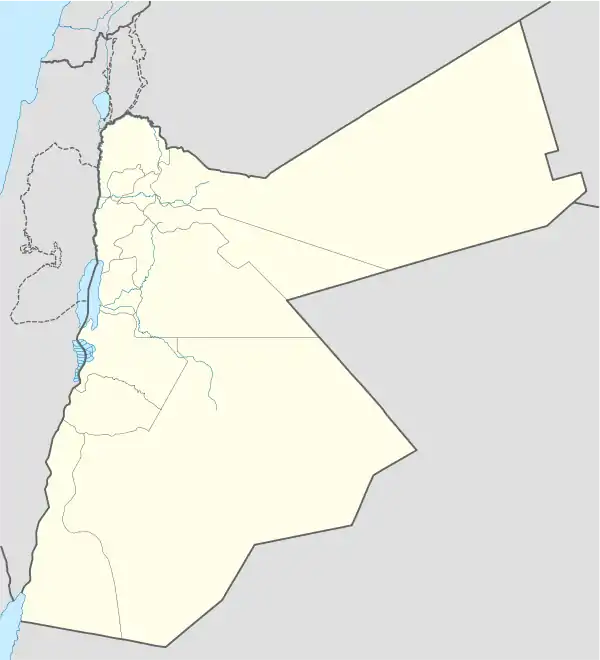Al-Shuna al-Shamalyah
Al-Shuna Al Shamalyah (Arabic: الشونة الشمالية) also known as North Shuna is a Jordanian city. It is located in Irbid Governorate, overlooking the Jordan River Valley. The city sits at the intersection of Highway 65 and Highway 10, and lies just south of the confluence of Yarmouk and Jordan rivers.
Al-Shuna Al Shamalyah
الشونة الشمالية | |
|---|---|
City | |
 Al-Shuna Al Shamalyah | |
| Coordinates: 32°36′36″N 35°36′29″E | |
| Grid position | 207/224 |
| Country | |
| Population | |
| • Total | 25,000[1] |
History
The Jordanian census of 1961 found 3,462 inhabitants in Al-Shuna al-Shamalyah.[2]
Sites
Tell esh-Shuneh
In 1953, archeologists Henri de Contenson and James Mellaart excavated the site of Tell esh-Shuneh, overlooking the Wadi Al Arab, just outside of the city. [3] The site was re-excavated in the 1980s by Carrie Gustavson-Gaube and again in the 1990s by Durham University. The artifacts recovered from Tell esh-Shuneh include remains of structures, pottery, and silver dating from the Chalcolithic and Early Bronze Ages.[4] Excavations also uncovered numerous macrobotanical remains, suggesting that both Chalcolithic and Early Bronze Age settlements at the site utilized agricultural irrigation.[5]
Shrine of Muadh ibn Jabal

The tomb of Muadh Ibn Jabal (Arabic: مقام الصحابي الجليل معاذ بن جبل رضي الله عنه), a prominent Sahabah of Muhammad and compiler of the Quran, is located in Al-Shuna al-Shamalya. The tomb is noted for its pleasant, yet allegedly unexplained smell.[6]
References
- arab48. "موقع عرب 48". موقع عرب 48. Retrieved 2016-12-11.
- Government of Jordan, Department of Statistics, 1964, p. 14
- Kafafi, Zeidan. "Henri De Contenson's Archaeological Fieldwork in the Eastern Part of the Jordan Valley: A Re-Evaluation". IFPO - Institut Français du Proche-Orient.
- GRAHAM, PHILIP; THILO, REHREN. "FOURTH MILLENNIUM BC SILVER FROM TELL ESH-SHUNA, JORDAN: ARCHAEOMETALLURGICAL INVESTIGATION AND SOME THOUGHTS ON CERAMIC SKEUOMORPHS". Oxford Journal of Archaeology. 15 (2). ISSN 0262-5253.
- Jenkins, Emma; Baker, Ambroise; Elliott, Sarah (2011), "Past plant use in Jordan as revealed by archaeological and ethnoarchaeological phytolith signatures", Water, Life and Civilisation (PDF), Cambridge University Press, pp. 381–400, doi:10.1017/cbo9780511975219.023, ISBN 9780511975219
- Blogger, Rawabat (2016-12-04). "Jordan and Jerusalem 2016: > Chasing the Fragrant Grave of Muadh Ibn Jabal". Jordan and Jerusalem 2016. Retrieved 2018-11-20.
Bibliography
- Government of Jordan, Department of Statistics (1964). First Census of Population and Housing. Volume I: Final Tables; General Characteristics of the Population (PDF).